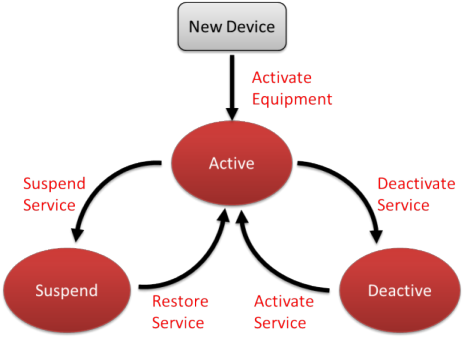About Device States
Contents
Introduction
As your M2M venture ramps up and matures, devices in your configuration will cycle through the three states of Active, Suspended, and Deactive for the following reasons:
- Operational issues
- Device-related issues
- Reassignment, either operational or location-driven
A device’s status changes as the result of a service provisioning action. The diagram below shows the actions that transition a device from state to state:

For a list of rules and constraints on provisioning actions, see Service Provisioning Rules.
Device States
A device’s status affects its ability to connect to the network, as well as the identifiers and attributes assigned to the device. Below are explanations of each device state in the Verizon Wireless B2B Network and the Verizon M2M Platform, followed by a table that summarizes the device states.
ACTIVE
A device with an ACTIVE status:
- Can connect to the wireless network
NOTE: Following the INITIAL activation of a device: An active 2G/3G device can only connect to the network after Over The Air Service Programming (OTASP), which can take various forms depending on the device’s manufacturer. An active 4G device can only connect to the network after receiving a new Access Point Name (APN) from the network, which happens automatically but takes about an hour after the device becomes active. Attempting to connect before either of these processes is complete will result in an authentication failure. - Has an MDN (2G/3G) or MSISDN (4G) assignment
- Has an IP address assigned from your pool
NOTE: If your organization has the Static IP feature applied, the device always gets the same IP address. If your organization has dynamic IP addressing, the device gets any free IP address from the pool. - Has an M2M Service Plan assignment in accordance with your contract
- Can cycle to either DEACTIVE or SUSPEND as a next state
A device is in the PENDING ACTIVATION state during the time between when the ChangeDeviceState-Activate request was sent and when the activation is completed and acknowledged by the Verizon Wireless Network. A device should only be in this state for a short time – perhaps a few minutes – but activation can take up to 24 hours if the network is extremely busy.
SUSPEND
A device with a SUSPEND status:
- Cannot connect to the wireless network
- Retains its MDN/MSISDN assignment
- Retains its IP address only when Static IP is an applied feature for your organization and the account associated with the device
- Has an M2M Service Plan assignment in accordance with your contract
- Can only cycle to ACTIVE as a next state
DEACTIVE
A device with a DEACTIVE status:
- Cannot connect to the wireless network as an M2M device
- Does not have an MDN/MSISDN assignment
- Does not have an IP address
- Does not have an M2M Service Plan assignment
- Can only cycle to ACTIVE as a next state
PRE-ACTIVE
The PRE-ACTIVE state is used on the ThingSpace Platform only, and does not have a corresponding state on the Verizon Wireless B2B network. The Connectivity Management POST /devices/actions/add request adds devices to account in the PRE-ACTIVE state but does not activate service for them. The only valid next-state is ACTIVE.
Summary
The following table summarizes the characteristics of the Verizon Wireless B2B Network device states:
| Device Status | Able to connect as M2M device? | Device has a MDN/MSISDN? | Device has a static IP Address? | Device has a Service Plan? | Valid Next State(s) |
|---|---|---|---|---|---|
| ACTIVE | Yes | Yes | Yes | Yes | DEACTIVE, SUSPEND |
| SUSPEND | No | Yes | Yes | Yes | ACTIVE |
| DEACTIVE | No | No | No | No | ACTIVE |